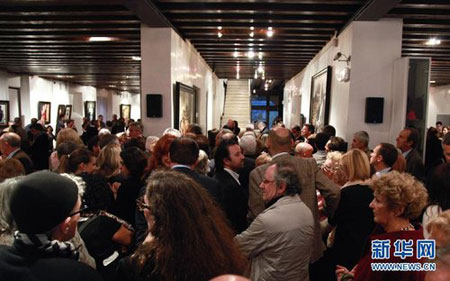- 中文
- EN
- Français
- 日本語
- 한국어
- 繁體中文
Exhibition on China's Millenary Roots Throws Light on Glorious Future: Italian Curator

A very important window on Chinese history has been opened in Europe thanks to "Manchu, the Last Emperor" exhibition which kicked off Saturday in northern Italy's town of Treviso, Italian curator Adriano Madaro told Xinhua.
The show, which will last till May 13, is the fourth of a series of exhibitions each covering a different period of China's history since the foundation of its empire, with exhibits carefully selected from the most famous archaeological sites and museums in China, Madaro said.
"Many of the objects which have been displayed in Treviso are listed as State treasures, and I must thank the Chinese government for allowing us to borrow exhibits which are normally locked away in security vaults," he said.

The curator highlighted that over the four exhibitions, started in 2005, more than a thousand exhibits have been displayed, from the Xi'an terracotta warriors to the jacket of China's last emperor Pu Yi.
The "Manchu, the Last Emperor" exhibition features over 250 robes, weapons, furniture and objects dating back to Qing Dynasty (1644-1911) including the Manchu iconic throne.
It also includes four paintings of Italian Jesuit Giuseppe Castiglione, who spent more than 50 years in China in the 18th century, as well as 15 large oil paintings, representing the Forbidden City and its major figures, by one of the greatest contemporary Chinese artists, Jiang Guofang.
"This project was made possible thanks to the precious help of historians, archaeologists, museums directors and Chinese friends who since 2003 have collaborated with generosity and enthusiasm, also accompanying me to the remotest archaeological sites," Madaro stressed.
A particularly productive cultural collaboration helpful for the Manchu exhibition was born from the curator's encounter with Jiang Guofang, Madaro recalled.
"I have been a lover of Chinese history since I was a student, and one day I was looking for books about the Forbidden City when my eye was caught by a monograph on the work of Jiang Guofang," he said adding that after he managed to get in touch with the artist.

Despite Jiang Guofang being one of Chinese "innovative" artists working in oil, who are a minority compared to those using the traditional techniques of ink and tempera, his subjects are not contemporary but the major Qing figures of the Forbidden City, Madaro said.
Madaro said it is the millenary history of China that makes it the great global power of the future.
"Therefore, artworks of such contemporary artists depicting China's glorious past, when put on show together with ancient treasures, can contribute to new roots of a millenary culture which is now more complete and universal," he noted.



